
Caddy is an open-source, lightweight web server designed to serve both static and dynamic sites. Open source, it runs on Linux, macOS Windows and BSD.
It supports HTTP/2 (and experimental HTTP/3), and is built for security. It is also optimized for scalability and uses as little global state possible.
Caddy supports HTTPS automatically and comes with many features which make it easier to use. They include a web administration interface, modular architecture and support for multiple websites on a single host.
The configuration file can be easily edited by humans and is extensible via plugins. Caddy is easily customizable and can be enhanced to meet your needs.
Windows also offers graceful config updates. They are stored locally so that they can still be applied to the system after a restart.

Caddy automatically rotates the logs after 100MiB, so your hard drive won't be cluttered.
Caddy, a webserver written in Go, offers better memory safety than C-based servers. It can handle high traffic volumes, and has a number of built in services such as template evaluation and Markdown rendering.
With its multiplexing functionality, it can serve multiple sites at the same time on the exact same port. It also supports automatic renewal and multiple SSL certificates.
It is highly extensible and supports many languages and frameworks. It can be extended with a plug-in system that implements long-running services and web standards.
Caddy can be easily customized to meet any requirement and deployed on different platforms. It's compatible with both containers and non-containerized servers.
Caddy's interface is extensible via a RESTful JSON api, which allows configuration from any app. The built-in Scheduler cron also lets you automate the updates. This makes Caddy ideal for deploying high-volume servers and platforms on the cloud.

Caddy, despite its versatility and flexibility, is not strictly open-source, and may not be suitable to commercial use. Caddy is a great choice for hosting your website or blog.
Installation
Installing Caddy involves installing a server binary locally and configuring the program to automatically start at boot. It is important to adjust ownership and permissions in order for only the root user to be able read and modify the files within the folder that you wish Caddy serve from.
You need an IP and a domain name to run your server. To get this token, you need to visit DigitalOcean. Create your personal access token and grant it read and write privileges.
Download the static binary for the platform you are using from the GitHub page. Then, you can follow the instructions provided on the website to install it and get it running. When you are ready, execute the server command on a terminal.
FAQ
What is a responsive website design?
Responsive Web Design is a method of designing responsive websites. It allows content to display on all devices (desktop computers, tablets and smartphones), so that it can be viewed easily on any device. This allows visitors to view the website on one device and access other features like buttons, navigation menus, etc. RWD aims to ensure that every user who views a site is able to view it on any screen size.
A website that sells primarily through eCommerce would be an example of this. You want your customers to be able to purchase products from your store, even if they are viewing it on a phone.
A responsive site will automatically adjust its layout based on the device being used to view it. Your laptop will view the website exactly as a normal desktop site. It will be different if the page is viewed from your phone.
This means that you can create one website that looks great across all devices.
What is a static site?
A static website is a site where all content are stored on a server, and visitors can access it via web browsers.
The term "static” refers the fact that there is no dynamic feature such as changing images or video, animations etc.
This site was initially designed for corporate intranets, but it has been adopted by individuals or small businesses who desire simple websites that don't require complex programming.
Because they are easier to maintain, static sites have been growing in popularity. They are simpler to update and maintain than fully-featured websites that have many components (like blogs).
They load much faster than dynamic counterparts. This makes them ideal for users on mobile devices or those with slow Internet connections.
In addition, static sites are more secure than their dynamic equivalents. You can't hack into a static site. Hackers only have access to the data that resides inside a database.
There are two main options for creating a static website.
-
Using a Content Management System (CMS)
-
Static HTML Website Creation
It all depends on what you need. A CMS is my recommendation if your first website was created.
Why? Because it gives you complete control over your website. A CMS means that you don't have to hire someone to set up your website. Upload files to the web server.
You can still learn to code and make a static website. However, you will need to put in some time to learn how to program.
Can I create my own website with HTML & CSS?
Yes! Yes!
Now that you know how to create the structure of a website, you'll also need to learn some HTML and CSS coding.
HTML stands as HyperText Markup Language. Think of it like writing a recipe for a dish. You'd list ingredients, instructions, and directions. HTML can also be used to inform a computer if certain parts of text should appear bold, underlined and italicized. It is the language used to describe documents.
CSS stands to represent Cascading Stylesheets. It's like a stylesheet for recipes. Instead of listing out each ingredient and instruction, you write down general rules for things like font sizes, colors, spacing, and more.
HTML tells the browser how to format a web page; CSS tells it how to do it.
Don't be afraid to ask questions if you don’t understand any of these terms. Follow the tutorials below, and you'll soon be making beautiful websites.
What should I include in my Portfolio?
These should all be included in your portfolio.
-
Examples of your previous work.
-
If applicable, links to your website
-
Links to your blog.
-
Here are some links to social media pages.
-
You can also find links to other designers' portfolios online.
-
Any awards you've received.
-
References.
-
Samples of your work.
-
These links will help you communicate with clients.
-
These links show that you are open to learning new technologies.
-
You are flexible, these links will show it.
-
You can find links that reflect your personality.
-
Videos showing your skills.
WordPress is a CMS.
Yes. It's a Content Management System. CMS is a way to manage your website content without having to use an application such Dreamweaver/Frontpage.
WordPress's best feature is its free pricing! Hosting is all you need, and it's usually free.
WordPress was initially created as a blogging platform, but it now offers many other options such as eCommerce sites, forums and membership websites. Portfolios are also available.
WordPress is easy to install and set up. You must download the installation file from their website and upload it onto your server. Simply visit the domain name from your web browser, and then log in to the new site.
After installing WordPress, it's necessary to register for a username. Once you've logged in, you'll see a dashboard where you can access all of your settings.
This is where you can add pages or posts, images and links to them. If you are comfortable creating and editing content, you can skip this step.
You can, however, hire a professional Web designer to handle the whole thing if your preference is to work with another person.
Statistics
- It's estimated that in 2022, over 2.14 billion people will purchase goods and services online. (wix.com)
- In fact, according to Color Matters, a signature color can boost brand recognition by 80%. There's a lot of psychology behind people's perception of color, so it's important to understand how it's used with your industry. (websitebuilderexpert.com)
- The average website user will read about 20% of the text on any given page, so it's crucial to entice them with an appropriate vibe. (websitebuilderexpert.com)
- At this point, it's important to note that just because a web trend is current, it doesn't mean it's necessarily right for you.48% of people cite design as the most important factor of a website, (websitebuilderexpert.com)
- It enables you to sell your music directly on your website and keep 100% of the profits. (wix.com)
External Links
How To
Drupal 7 Web Design: How to use it
Drupal is the most used Content Management System (CMS) of today. It was created in 2003 by DriesBuijtaert from Belgium. The name comes from the two first letters of its developer's names, Dirk Buijtewaard and Pierre d'Herbemont. Drupal was opened source in 2005. Since then there have been many versions. Drupal is still used by many companies and websites all over the globe.
Drupal is a popular choice for website owners because of several reasons. It is easy to download and install. It's easy to customize and extend. Third, it is very well documented. It provides tremendous support via IRC channels and forums. Fifth, it is extensible via modules. Sixth, it can support multiple languages. It is also easily customizable. It is also scalable. Ninth, it is secure. Tenth, its reliability is assured. Finally, it is supported and maintained by the community. Drupal is a great choice for your next project because of all these factors.
You might wonder what makes Drupal stand out from other CMS platforms. It's easy. Drupal is an open-source content administration system. Drupal is completely free and can be downloaded freely. With Drupal, you have complete control over your website. You can add or remove pages, change colors, fonts, images, videos, etc.
Drupal is an option for those who lack the technical skills required to create websites. Unlike other CMS, you don't need to know anything about programming to start building your website. You only need to know how Drupal works. Then you will be able to modify your website according to your needs.
Another benefit of using Drupal is its many pre-built themes and plugins. These plugins will allow you to increase the functionality of your website. To gather contact information from your visitors, you could use the Contact Form Module. Google Maps also allows you to display Google Maps on your website. Drupal comes with many ready-made templates. These templates give your website a professionally designed look.
Drupal is flexible, too. Drupal can be used to create new modules or to replace existing ones. If you are looking to integrate social networks into your website, this is possible quickly. You can also setup RSS feeds or e mail subscriptions.
In addition, Drupal is highly customizable. You can add custom fields and forms, manage users, and more. You can also create complex layouts with Drupal.
Drupal is resilient and reliable. It is stable and scalable. It offers outstanding security features. Drupal is a solid web development platform.